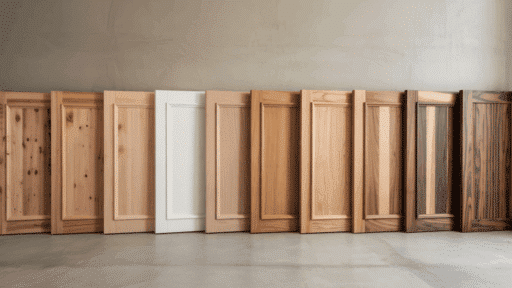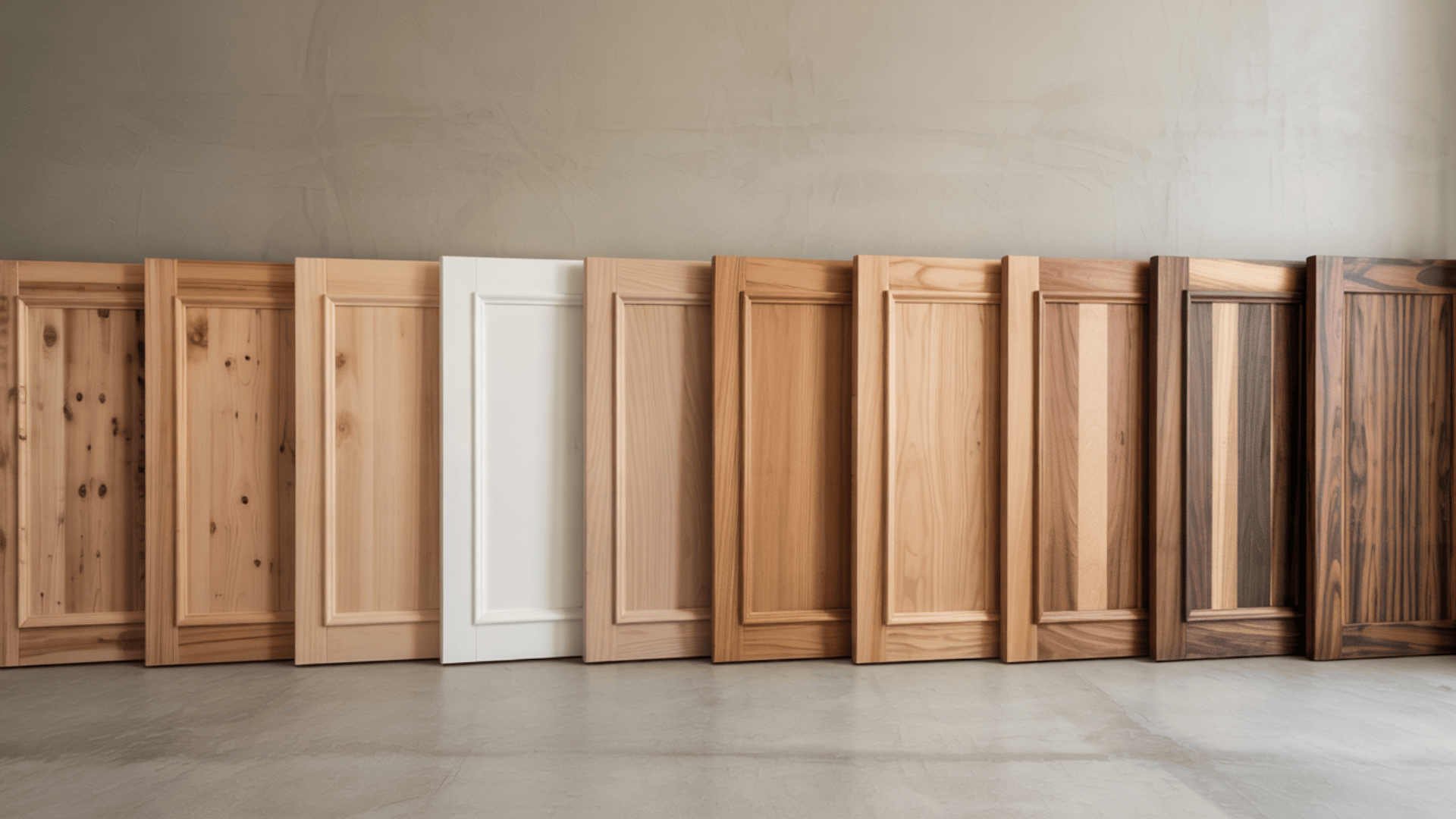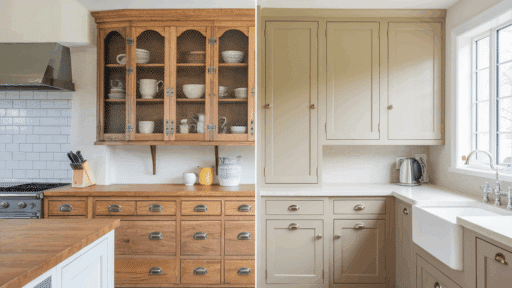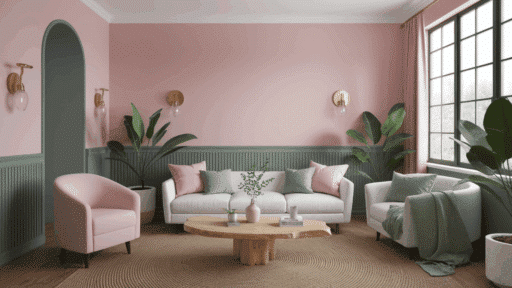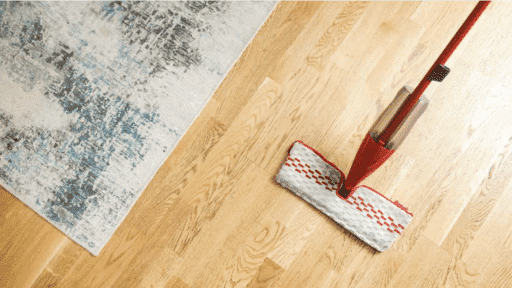Choosing cabinet wood is more than just picking a color you like. The type of wood you select can dramatically change the look, performance, and price of your kitchen.
From budget-friendly pine to luxury walnut and exotic teak, every wood species comes with its own unique personality and associated cost.
Some are built to last a lifetime, while others offer beauty on a tighter budget. And it’s not just about wood alone. Construction methods, door styles, and finish types all play a role in your final investment.
If you’ve ever felt overwhelmed comparing cabinet prices or wondered what makes one wood more expensive than another, you’re in the right place.
This will break it all down, piece by piece, price by price; so you can plan with confidence, style with intention, and spend smart.
What Makes Cabinet Wood Expensive?
Several factors influence the cost of wood cabinets. Wood rarity plays a significant role; common woods, such as pine, cost less than exotic species like teak.
Local woods typically cost less than imported ones. Grain patterns also matter, as woods with unique or attractive grain patterns command higher prices.
Plain grain costs less than figured or bookmatched patterns. Hardness and durability impact price since harder woods last longer but cost more upfront.
Softwoods initially save money, but may require replacement sooner. Processing difficulty affects labor costs because some woods are easier to cut, sand, and finish than others.
Understanding Natural Wood Cabinet Colors
Cabinet wood color can change the whole feel of your kitchen.
Light woods like pine and maple make spaces feel bright and open, while dark woods like cherry or walnut add warmth and richness.
Medium-tone woods like oak offer a balanced, classic look that fits many styles. Some woods naturally darken over time; cherry, for example, starts light and deepens to a rich red-brown.
You can also stain or paint most woods to match your design. Knowing the natural tone of your chosen wood helps you plan finishes, wall colors, and hardware that complement each other well.
If you want a soft farmhouse look or a bold modern space, wood color plays a big part in the result.
Budget Wood Options ($15-40 per Linear Foot)
Budget-friendly wood options provide solid wood cabinets without breaking the bank. These woods work well for painted finishes, utility areas, or first-time homeowners building their dream kitchen gradually.
Pine Cabinets ($15-25 per Linear Foot)

Pine offers the lowest cost for solid wood cabinets. This softwood features a light color with visible grain lines and knots, creating a rustic charm.
Key Features: Lightweight construction, prominent knots, easy staining, natural honey color that darkens with age.
Styling Tips: Paint pine cabinets white or cream for farmhouse appeal. Use knotty pine for rustic cabin looks. Sand knots smooth for a cleaner appearance. Pair with simple hardware to avoid overwhelming the natural character.
Poplar Cabinets ($20-35 per Linear Foot)
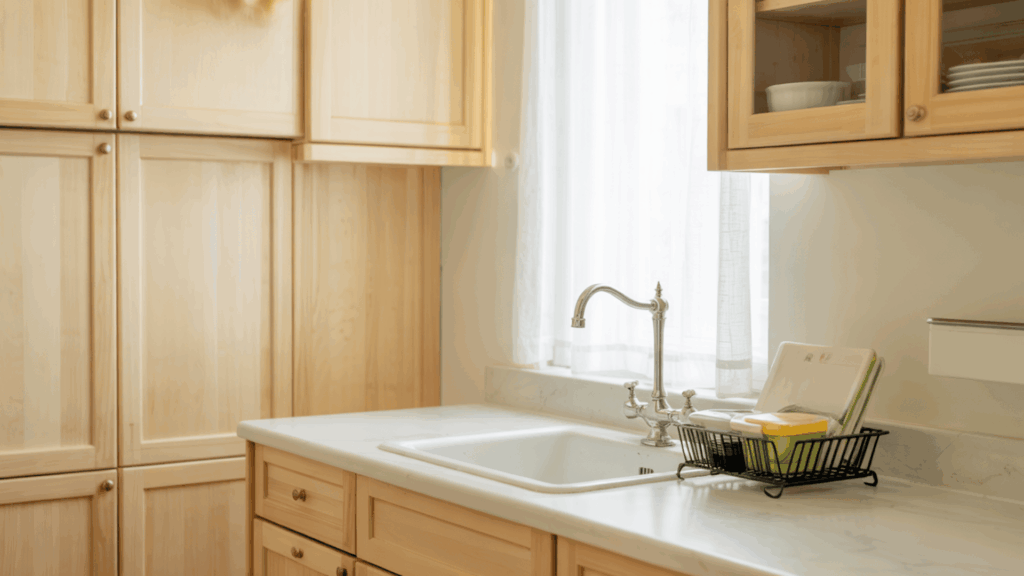
Poplar provides a smooth, even surface ideal for painted cabinets. This hardwood has minimal grain and a light green-yellow color that disappears under paint.
Key Features: Smooth texture, consistent density, excellent paint adhesion, minimal grain patterns, stable construction.
Styling Tips: Use poplar for bold painted colors like navy, sage, or charcoal. Apply primer first for the best paint results. Choose flat panel doors for a modern look. Add decorative hardware since wood grain won’t compete.
Birch Cabinets ($25-40 per Linear Foot)
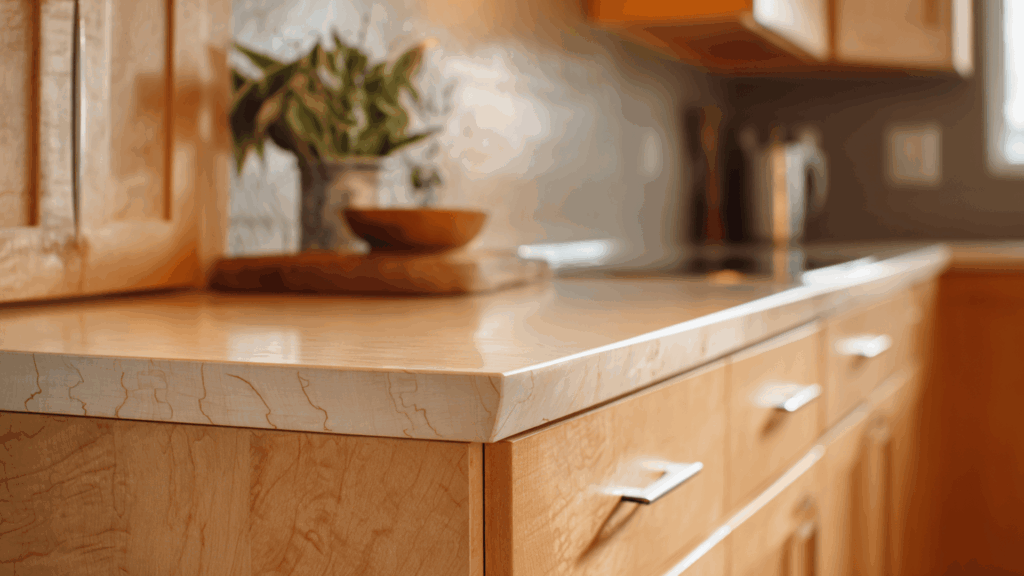
Birch provides excellent value with its fine, even grain and light color. This hardwood offers good durability at a reasonable price.
Key Features: Fine-grain pattern, light natural color, hard density, smooth finish, takes stain evenly.
Styling Tips: Stain birch in medium tones, such as honey or cherry, for added warmth. Use a clear finish to highlight the subtle grain. Pair with brushed nickel hardware for contemporary appeal. Works well with both traditional and modern door styles.
Mid-Range Wood Options ($40-80 per Linear Foot)
Mid-range woods offer the perfect balance of durability, beauty, and value. These species provide professional-quality results that work well in busy kitchens while staying within reasonable budgets.
Maple Cabinets ($40-65 per Linear Foot)
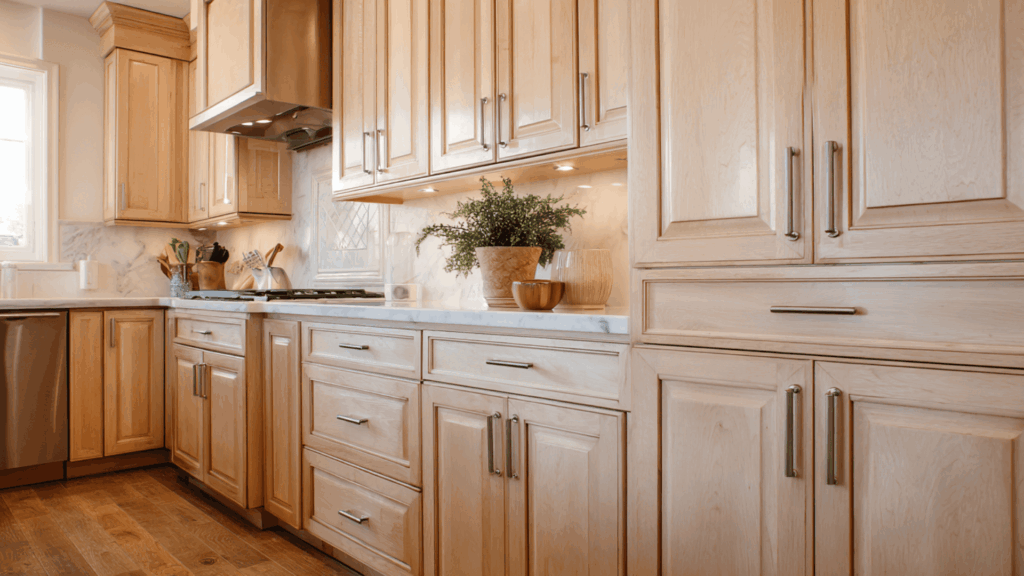
Maple ranks as the most popular cabinet wood due to its durability and clean appearance. This hardwood features a tight, subtle grain pattern that complements any style.
Key Features: Tough density, smooth texture, tight grain, light color, excellent durability, and resistance to dents and scratches.
Styling Tips: Use natural maple for Scandinavian or modern looks. Stain darker for traditional appeal. Pair with simple hardware to accentuate the wood’s quality. Works beautifully with both painted and stained finishes.
Oak Cabinets ($45-70 per Linear Foot)
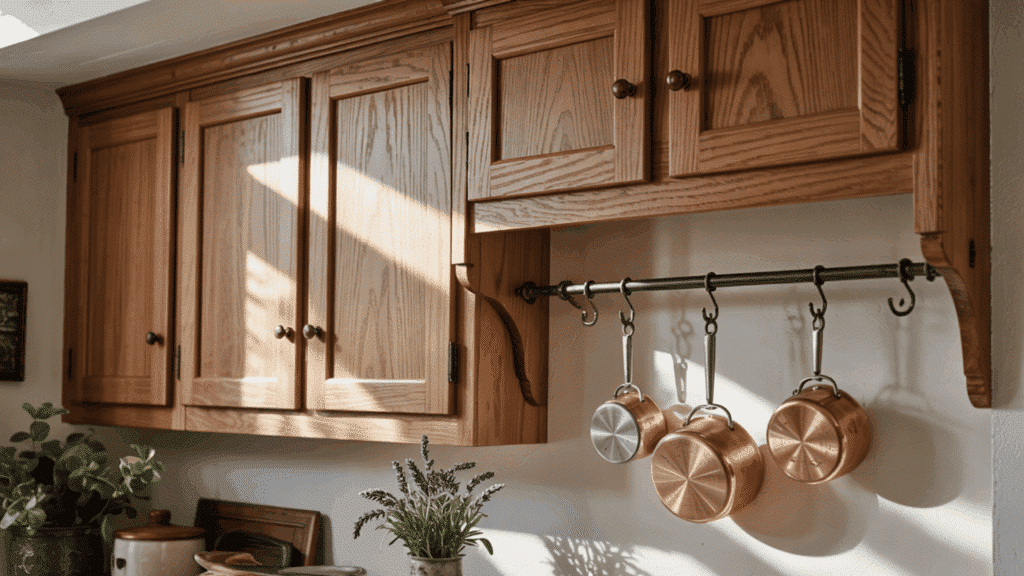
Oak brings traditional appeal with its prominent grain pattern. This classic hardwood has been used for centuries in furniture and cabinetry.
Key Features: Pronounced grain pattern, golden color, extremely durable, classic appearance, available in red and white varieties.
Styling Tips: Use red oak for warm, traditional kitchens. Choose white oak for cleaner, more modern looks. Pair with bronze or brass hardware for classic appeal. Works best with raised panel doors that showcase the grain.
Ash Cabinets ($50-75 per Linear Foot)
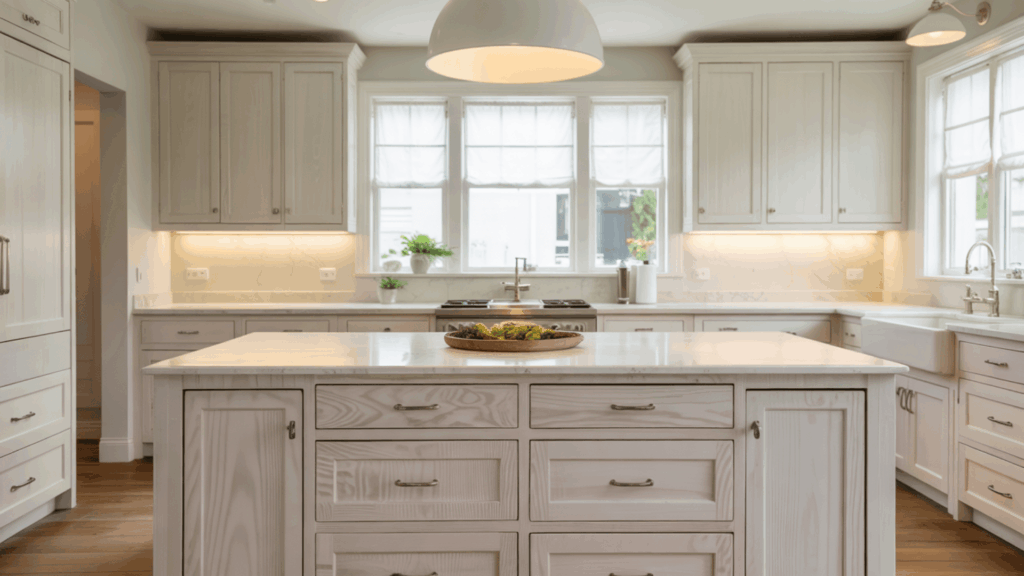
Ash offers a light color with pronounced grain similar to oak. This hardwood provides strength and flexibility for cabinet construction.
Key Features: Light cream color, open grain pattern, excellent strength, flexible yet durable, takes stains well.
Styling Tips: Stain ash in gray tones for modern farmhouse appeal. Use a natural finish to highlight the grain pattern. Pair with black hardware for contemporary contrast. Works well with both flat and raised panel doors.
Premium Wood Options ($80-150+ per Linear Foot)
Premium woods represent the pinnacle of cabinet craftsmanship and natural beauty. These species offer unique characteristics, stunning grain patterns, and luxurious appeal that create showpiece kitchens.
Cherry Cabinets ($80-120 per Linear Foot)
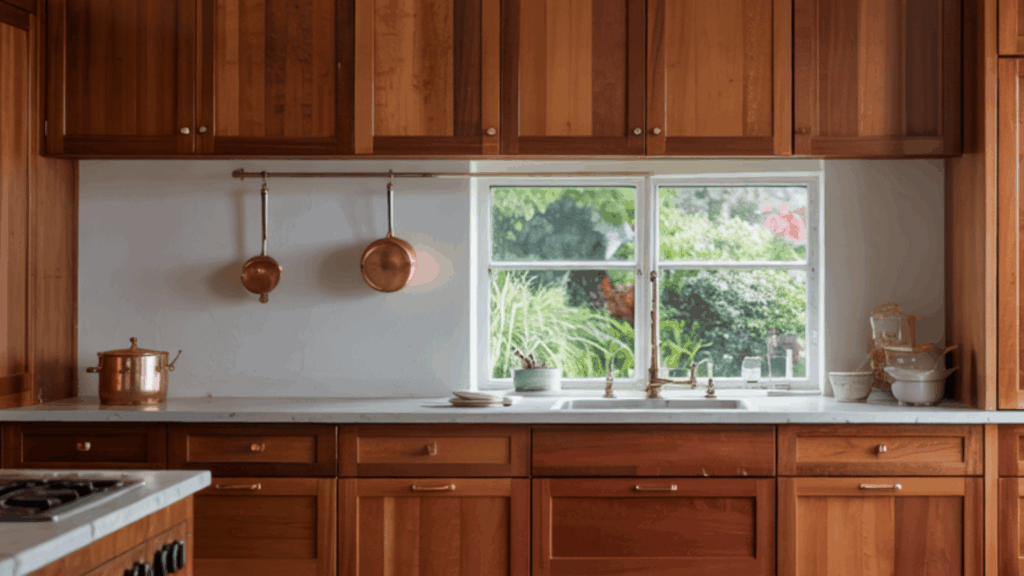
Cherry represents luxury in cabinet wood. This hardwood starts light and darkens to a rich reddish-brown over time.
Key Features: Rich reddish color, smooth fine grain, darkens with age, excellent workability, luxurious appearance.
Styling Tips: Use natural cherry for formal traditional kitchens. Pair with antique brass hardware for a classic look. Choose raised panel doors to showcase the beauty of the wood. Allow natural aging for deeper color development.
Walnut Cabinets ($100-150 per Linear Foot)
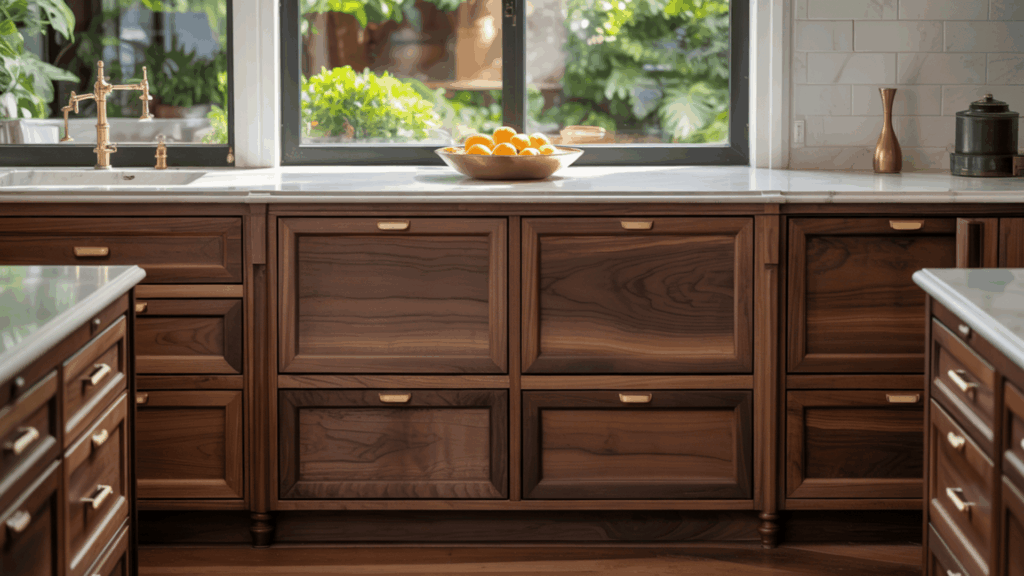
Walnut delivers stunning chocolate-brown tones with beautiful grain patterns. This premium hardwood is highly sought after for luxury projects.
Key Features: Rich chocolate color, distinctive grain patterns, premium appearance, excellent natural finish, highly figured wood.
Styling Tips: Use walnut for contemporary luxury kitchens. Pair with matte black hardware for modern appeal. Choose flat-panel doors to highlight the grain. Mix with lighter woods for striking contrast.
Exotic Woods ($120-200+ per Linear Foot)
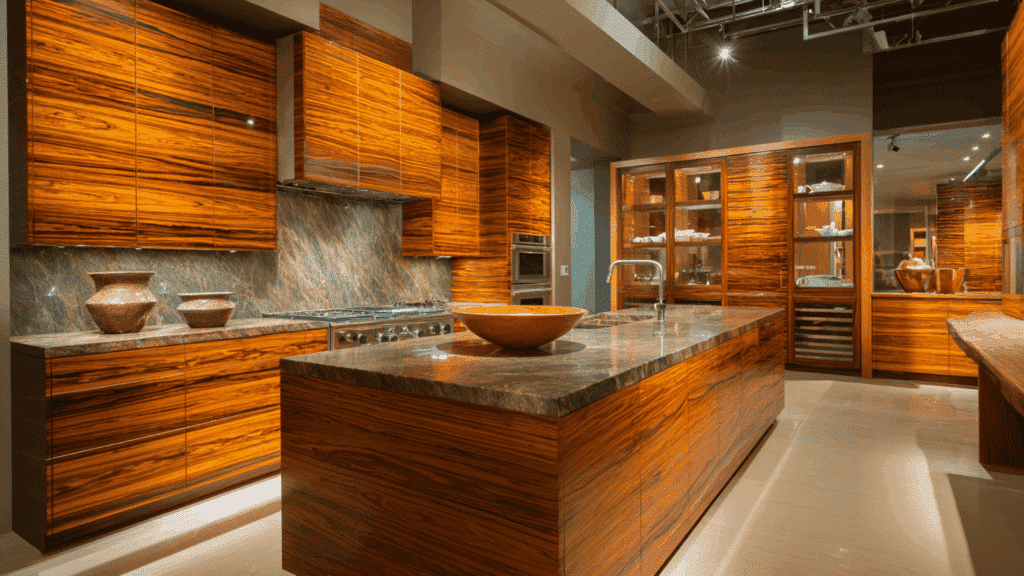
Exotic species like teak, mahogany, and zebrawood offer unique colors and patterns. These rare woods create one-of-a-kind cabinet looks.
Key Features: Unique colors and patterns, rare availability, distinctive appearance, natural water resistance, conversation-starting appeal.
Styling Tips: Use exotic woods as accent pieces rather than as the primary material for entire kitchens. Pair with neutral colors to let wood shine. Choose simple hardware to avoid competing with natural beauty. Consider sustainability certifications when purchasing.
Quick Price Comparison
This table summarizes the key details for each wood type, allowing you to compare options at a glance. Use this reference to narrow down your choices based on your budget, durability needs, and maintenance preferences.
| Wood Type | Price Range | Durability | Maintenance | Best Use |
|---|---|---|---|---|
| Pine | $15-25 | Fair | Medium | Budget projects |
| Poplar | $20-35 | Good | Low | Painted cabinets |
| Birch | $25-40 | Very Good | Low | Contemporary |
| Maple | $40-65 | Excellent | Low | High-use areas |
| Oak | $45-70 | Excellent | Medium | Traditional |
| Ash | $50-75 | Very Good | Medium | Modern rustic |
| Cherry | $80-120 | Very Good | Medium | Luxury traditional |
| Walnut | $100-150 | Very Good | Medium | High-end modern |
What Affects the Final Cabinet Cost?
Wood type is just one piece of your cabinet budget puzzle. Construction methods, door styles, and finish choices can significantly impact your final investment. Understanding these factors helps you make informed decisions and avoid surprise costs.
- Construction method matters: solid wood is pricier but more durable, while veneers over plywood offer savings with a wood-like appearance.
- Face frame cabinets cost more due to the added material and traditional style; frameless designs are generally cheaper and better suited to modern tastes.
- Door style complexity affects cost; flat panels are more affordable than raised or decorative options, such as mullions and curves.
- Finish type impacts pricing: clear coats are generally less expensive, while stains, glazes, and hand-rubbed finishes add to the overall cost.
- Special effects, such as distressing or antiquing, increase labor and material expenses, making them more expensive overall.
Total Project Cost Example
These real-world examples show how wood choice affects your total kitchen cabinet investment. Hardware costs vary based on quality, while installation costs remain consistent across different wood types.
| KITCHEN SIZE | WOOD TYPE | WOOD COST | HARDWARE | INSTALLATION | TOTAL COST |
|---|---|---|---|---|---|
| 15 linear feet | Pine | $300 | $225 | $1,050 | $1,575 |
| 15 linear feet | Maple | $750 | $300 | $1,050 | $2,100 |
| 15 linear feet | Cherry | $1,500 | $450 | $1,050 | $3,000 |
| 20 linear feet | Birch | $600 | $300 | $1,400 | $2,300 |
| 20 linear feet | Oak | $1,100 | $400 | $1,400 | $2,900 |
| 20 linear feet | Walnut | $2,500 | $600 | $1,400 | $4,500 |
The Bottom Line
Cabinet wood types aren’t one-size-fits-all. Your final cost depends on more than just looks; it’s about durability, finish choices, and how the wood handles wear over time.
Budget options like pine and poplar work well for starter kitchens or those with painted finishes, while maple and oak offer dependable strength at a mid-range price.
Premium species like cherry and walnut bring undeniable beauty, while exotic woods offer unmatched uniqueness, at a higher price.
If you’re modeling on a budget or designing a luxury space, understanding your wood choices ensures you get beauty, value, and long-term satisfaction.
Ready to plan your kitchen with confidence? Save this guide, compare your top picks, and consult with a cabinet pro when you’re ready to bring your vision to life.

